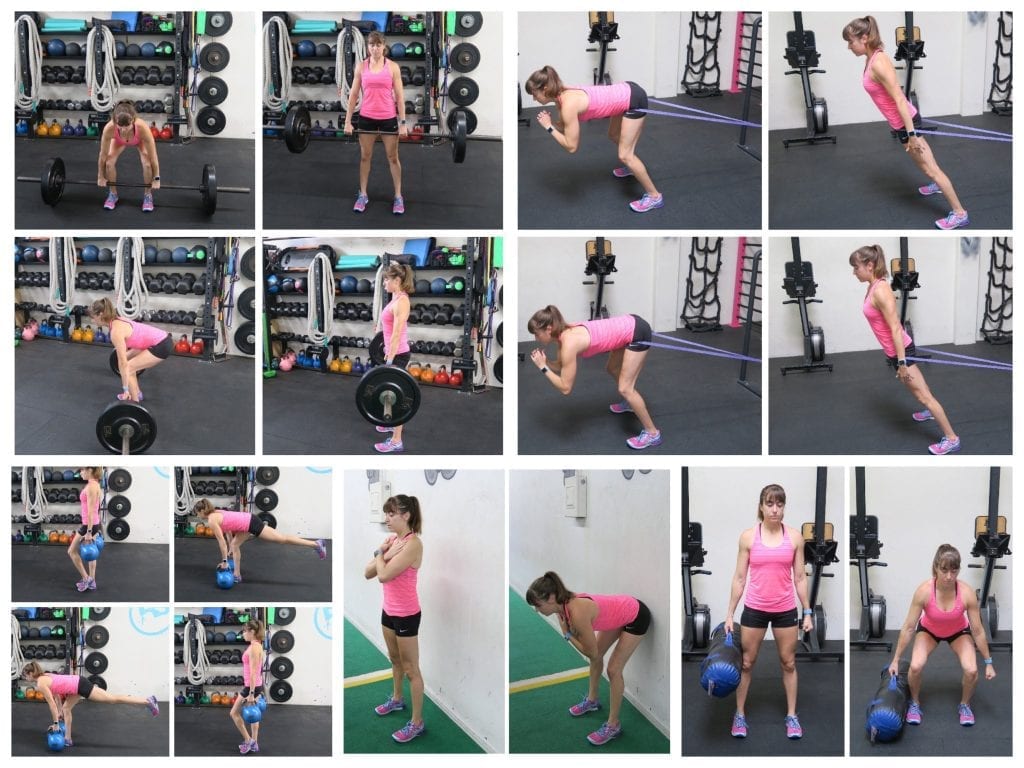The Deadlift is a technical movement and one that can be…well…scary!
But there are ways to break down the exercise and perfect that hip hinge movement even if you, or your client, is just starting out!
So what does the Deadlift work?
The Deadlift will work your entire backside – your upper back, lats, hamstrings and glutes. It will also work your abs.
But too often people ONLY feel their lower back working, which can lead to overload and injury. It’s why sometimes the Deadlift can be considered a “dangerous” move.
And that’s why it is key we first really learn how to perform the Deadlift hip hinge movement pattern correctly.
The hip hinge is a movement where you hinge or bend at the hips to push your butt back toward the wall behind you.
The key is really pushing your butt back so you can balance and load your glutes.
Your knees will be soft, but unlike a squat, you will not try to sink or lower your butt toward the ground. Bending your knees should NOT be your focus. The exact amount of knee bend you include will even vary based on the Deadlift variation you use.
While most often we see this exercise done with a barbell, that variation is more advanced than we give it credit for.
So if you, or your client, is just starting out and trying to learn how to properly hinge at the hips to load the glutes, you may not want to jump right into using the barbell.
Instead using a tool like a kettlebell (dumbbells work too) or band can be a good place to start.
The kettlebell or dumbbells make it easier to focus on loading your glutes while still working your upper back, lats, abs and hamstrings without your weight shifting forward.
While the band allows you to break down the movement a bit and really focus on working your glutes using the hip hinge movement. This move is actually a great accessory exercise as well to include even as you advance (aka I use this even with many of my advanced lifters to strengthen their glutes!).
And if you’ve wanted to use the Single Leg Deadlift (either yourself or with your clients) to improve your balance and prevent injuries, but your balance is…well…not so good, the slider and 80/20 variations are great option.
Both of these give you a balance “assist” while still forcing each side to work independently.
But even though these may take out some of the balance challenge, they aren’t easy moves by any means and even advanced exercisers should include them as accessory exercises because they do allow you to potentially use heavier loads than the full unilateral or single leg variation.
So if you are just starting out, or training a client new to exercise, and want to use that amazing Deadlift movement, try these variations to start!
Make sure to watch the full video for more tips and coaching cues!
Want To Learn More To Really MASTER The Deadlift?
Check out my Mastery Series – Deadlift Edition!





Thanks ! This is very helpful. I just did deadlift for first time with my trainer this past Tuesday. This will help me with it at home, where I will emphasize the kettle bell approach you give as an alternative. I am a 62 year-old male with no meaningful gym history and , therefore, I am cautious about the injury factor. I am also guarded in that respect as I do not want a repeat of the herniated disc of 18 years ago. That was actually the result of a poorly treated injury from 15 years prior, piled on with alot of continuous neglect on my part. Twin grandsons introduced into my life three years ago have changed my attitude !Your content here and on YouTube is of great quality, and I am glad the algorithm bumped me your way. I will continue to visit. Keep it up !
Hi Steve! Sorry I missed this earlier! So glad you’re starting to use deadlifts and progressing slowly. Even using these variations to make sure you’re loading correctly as you work with your trainer will be key! You definitely also want to make sure to be doing the glute activation and core work to help protect that lower back in general and prevent compensations! Always here to help if you need anything!
Is indeed absolutely great info you shared with us ! Appreciate it. I had romanian deadlifts for quite some time in my routine and after reading your article I added sumo deadlifts as well. Thing is that I dont feel my glutes working when sumo deadlifting even though I religiously go though glutes activation and the posture is apparently as supposed to, I work with 40kgs (including the bar’s weight) so I should surely feel a muscle working if correctly targeted … I cant figure out where I might be doing wrong. I will continue watching and improving the posture. Thank you a lot for all the great info you share!
Do you have a recommendation on the resistance band you were using?
Hope this helps! It’s all of the tools I use – https://amazon.com/shop/redefiningstrength